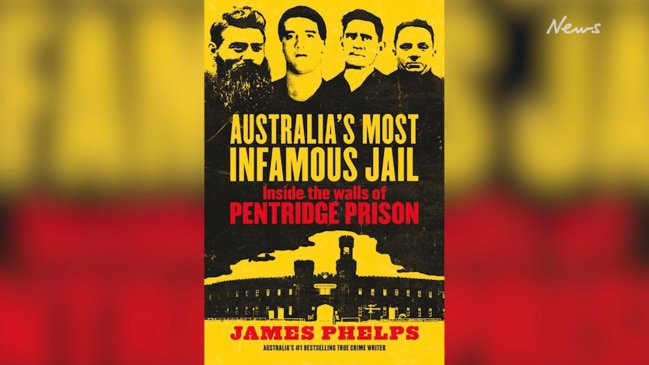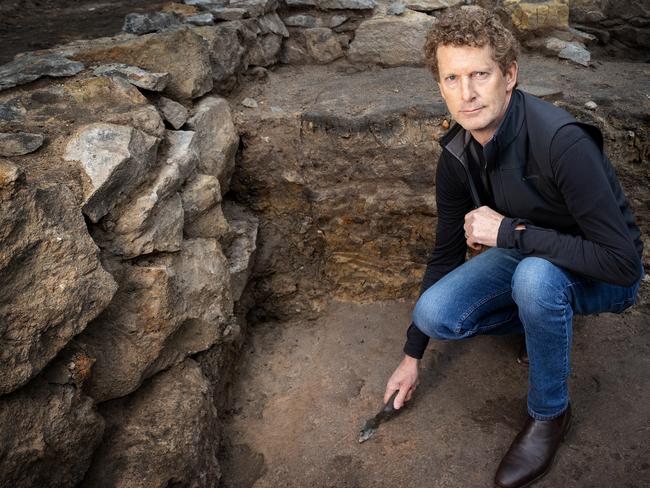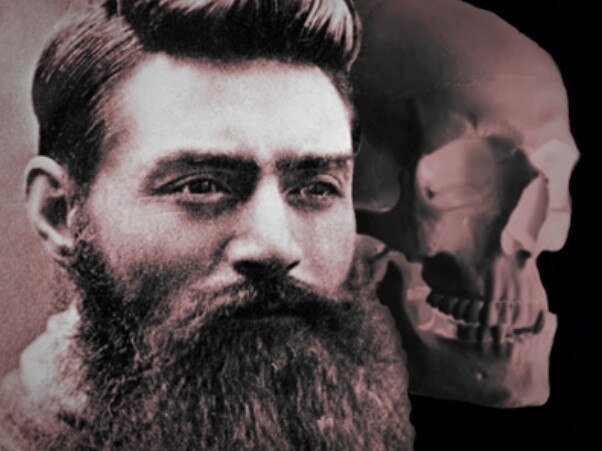‘It was never stolen’: Ned Kelly skull mystery solved
One of Australia’s greatest mysteries has been solved with the shock discovery of what really happened to the country’s most famous outlaw. Listen to the audio.

Behind the Scenes
Don't miss out on the headlines from Behind the Scenes. Followed categories will be added to My News.
The mystery of Ned Kelly’s missing skull has finally been solved.
In a twist befitting of a saga that started with an exhumation, continued with a stolen skull, and then with a lost grave, the archaeologist who eventually found Ned Kelly’s missing remains has revealed that the famous outlaw’s skull was never nicked at all.
“It was actually never stolen,” said Heritage Victoria senior Archaeologist Jeremy Smith said. “Or missing.”
Speaking to No.1 best-selling true-crime author James Phelps in his soon-to-be-released book Australia’s Most Infamous Jail: Pentridge, Smith said new forensic testing had revealed that Kelly’s skull was buried in a toolbox with the rest of his remains and not put on display at the Old Melbourne Gaol and subsequently stolen in 1978 as previously thought.

“There were parts of his skull in his burial box,” Smith said.
“People still seem to think about the mystery of the missing Kelly skull, but it’s no mystery at all. We have significant parts of the Kelly skull that have been confirmed with DNA testing.”
Listen to the audio clip below about how the mystery of Ned Kelly became an “Indiana Jones-like” mission.
In a remarkable story that reveals how a team of archaeologists, historians, scientists, politicians and a backhoe driver dug deep to solve one of the country’s greatest mysteries, the riddle of what happened to Australia’s most famous outlaw, Phelps details the full account of how Kelly’s remains were lost after his remains were relocated from the Old Melbourne Gaol to Pentridge Prison in 1929 and then found in 2009 after a seven-year search.
“It really was an Indiana Jones-like project,” Smith said. “Missing skulls and burial grounds, the mystery of Ned Kelly. It was one of those projects that got weirder and weirder. I work in a government department, so I was always going to my boss with strange requests. Like the day I asked him if I could go to Glenrowan to meet a guy who claimed he had Ned Kelly’s skull. It was amazing how it all came together.”

Thought to be buried in a marked plot at Pentridge prison, Edward E. Kelly’s remains were officially declared lost in 2002 when a team of archaeologists attempted to exhume his grave.
“Edward Kelly was clearly marked on the document beneath one of the mass graves,” Smith said. “It looked as though the grave he was in included the first of the graves that were dug up and moved to Pentridge in 1929.”
“Nothing was where it was supposed to be,” Smith said. “The area that was referred to as “The Pentridge cemetery” was supposed to contain the remains of all the people who were judicially executed in Pentridge, but it soon became clear that, at Pentridge, “x” certainly didn’t mark the spot.”
Smith and his team continued digging around the Pentridge site in a bid to find Kelly’s remains.

“We found Ronald Ryan’s remains in what was thought to be the prison cemetery, but that was all,” Smith said. “From what we could work out, the location of the original [cemetery] had been forgotten sometime between the execution that proceeded Ryan, in 1951, and Ryan’s execution in 1967. Or perhaps the earlier burial ground was considered to be “full”.’
During a seven-year search of the sprawling Pentridge site, Smith and his team located four mass graves containing the remains of 30 executed inmates – but there was no sign of Kelly.
“I thought it was highly likely that trophy collectors had pillaged what was left of his remains in 1929.”
The hunt for Kelly’s remains was reignited when a stolen skull, believed to be Ned Kelly’s was returned.
“I received a phone call from a guy called Mr Tom Baxter,” Smith said. “And he told me that he had Ned Kelly’s skull.
“Tom was the person associated with the theft of a skull from the Old Melbourne Gaol in 1978. The skull, which was on display at the gaol at the time, was one of four that had been given to the National Trust by the Institute of Anatomy in Canberra in 1971. The skulls were believed to be those of executed inmates and, at the time of the theft, one of the skulls was being displayed as that of Ned Kelly, alongside his death mask. The skull had the name E. Kelly written on the left side of the cranium.”

Baxter agreed to hand over the skull. He arranged to fly over from Perth and meet Smith.
“It kept on getting weirder,” Smith said. “He wanted to meet in Glenrowan. And he rocks up and hands me a tooth.”
Smith was able to convince Baxter to come back with the whole skull, which arrived in Melbourne from Perth travelling in his personal baggage.
“Ultimately it was proved that the skull did not belong to Kelly,” Smith said. “There was some suggestion that it belonged to Frederick Deeming, the man suspected of being Jack the
Ripper, but that was disproved through DNA testing. So, in a nutshell, we could not find Kelly’s remains and we doubted that we ever would.”
Kelly’s remains were eventually discovered in 2009 after a backhoe operator unearthed another mass grave during the redevelopment of the former prison site.
“Kelly ended up being the most complete skeleton that we found,” Smith said. “His skeleton was 90 per cent complete.”

And in a new revelation, that box also included his skull.
“Those fragments have cut marks that show it was sectioned as part of an autopsy following his execution,” Smith said.
“Kelly’s skull ended up in multiple parts and what was left was put in the box. We have a few pieces of his skull, and whatever is missing either deteriorated or was thrown away during the autopsy or when his remains were exhumed and reburied in 1929 and possibly in the 1950s. He had been moved three times when we started our project, the third time being during works at Pentridge, so to find him largely intact is a minor miracle.”
More Coverage
Originally published as ‘It was never stolen’: Ned Kelly skull mystery solved




